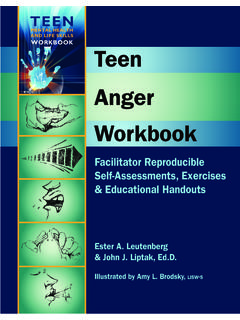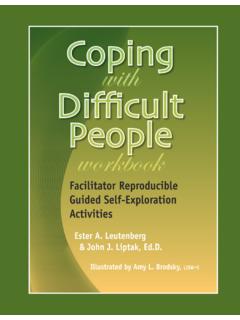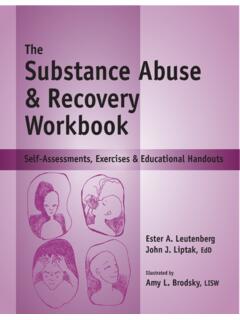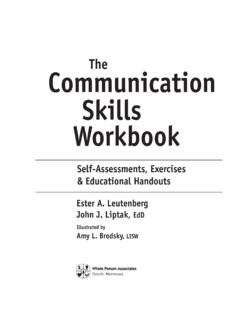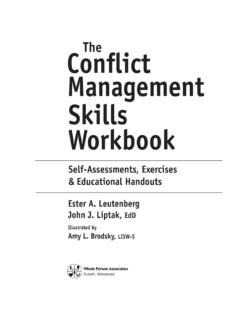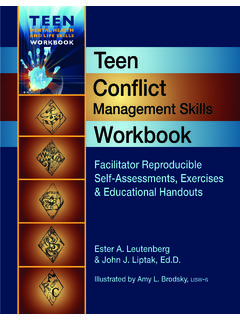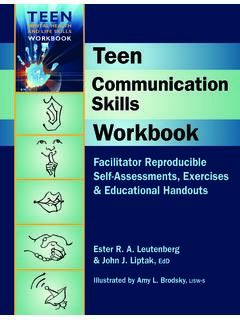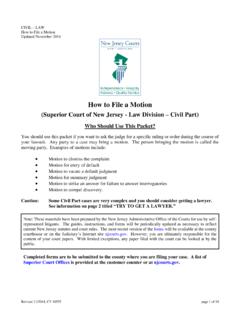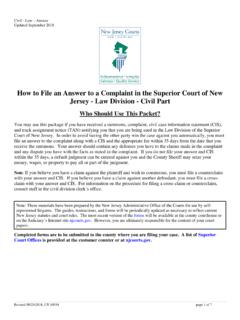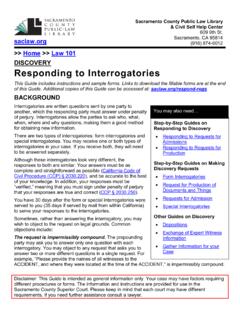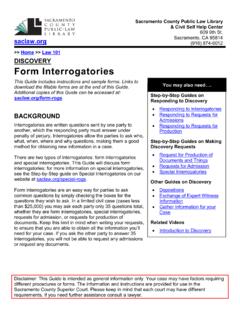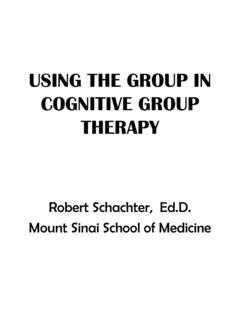Transcription of The Wellness Lifestyle Wellness Workbook Lifestyle Workbook
1 Wellness LifestyleTheWorkbookSelf-Assessments, Exercises & Educational HandoutsEster A. Leutenberg John J. Liptak, EdDIllustrated byAmy L. Brodsky, LISWD uluth, MinnesotaWellness LifestyleTheWorkbookSelf-Assessments, Exercises & Educational HandoutsJohn J. Liptak, EdD Ester A. LeutenbergIllustrated byAmy L. Brodsky, LISWC opyrighted Material Purchase at Person 101 W. 2nd St., Suite 203 Duluth, MN Wellness Lifestyle Workbook Self-Assessments, Exercises & Educational HandoutsCopyright 2009 by Ester A. Leutenberg and John J. Liptak. All rights reserved. Except for short excerpts for review purposes and materials in the assessment, journaling activities, and educational handouts sections, no part of this book may be reproduced or transmitted in any form by any means, electronic or mechanical, including photocopying without permission in writing from the in the United States of America10 9 8 7 6 5 4 3 2 1 Editorial Director: Carlene Sippola Art Director: Joy Morgan DeyLibrary of Congress Control Number: 2009925430 ISBN: 978-1-57025-233-4 Copyrighted Material Purchase at This Book (For the professional) Wellness and health are interrelated, but distinct concepts.
2 Health is considered freedom from disease; it is the condition in which people are able to do their most constructive work, provide the best possible service to the world, and experience the highest possible enjoyment in leisure-time experiences. Wellness , on the other hand, is much more complex than basic physical health. Wellness is the ability to fully integrate physical, mental, emotional, social, and spiritual well-being into an effective Lifestyle . Optimum Wellness balances the following five basic dimensions:Physical Dimension This dimension is related to sound nutritional practices, maintaining proper weight, participating in regular exercise, getting enough sleep, engaging in physical activity, avoiding risky behavior, and restricting intake of harmful substances. Career Dimension This dimension is related to finding balance among various life roles as people engage in fulfilling work and related activities, and identifying leisure activities that will provide a sense of life satisfaction.
3 Emotional Dimension This dimension is related to understanding personal feelings, maintaining a relatively even emotional state, accepting one s own limitations, expressing emotions effectively, adjusting to change, and maintaining good, healthy relationships with other people. Social Dimension This dimension is related to sharing friendships, family relationships and group memberships. It entails using empathy and active listening skills, caring genuinely about other people, being open to caring from other people, and committing to the common good of the community, nation, and Dimension This dimension is related to maintaining a sense that life is meaningful, employing a continuing quest for value and purpose, searching for clarity, committing to peace and contentment in life, and developing the fortitude to continue in the face of Wellness Lifestyle pervades all aspects of a person s life independent and with others in school, work, leisure, community activities and in a group.
4 A Wellness Lifestyle helps to minimize stress and promote well-being and self-fulfillment. The notion of Wellness suggests that people are whole beings, not fragmented parts that can be dealt with separately. Wellness stresses conscious effort and commitment to one s ability to resist disease and maintain optimum health.(Continued)Copyrighted Material Purchase at This Book (For the professional, continued)The Wellness Lifestyle Workbook contains five separate sections and a bonus section to help participants learn more about themselves and their lifestyles. They will learn about a Wellness Lifestyle that promotes health and well-being. The sections of this book are:1) COPING WITH STRESS SCALE helps individuals identify their basic style for dealing with ) PHYSICAL FITNESS SCALE helps individuals identify if they are eating well, getting plenty of relaxation sleep and exercising regularly in order to be able to cope effectively with ) CREATIVE LEISURE SCALE helps individuals explore their leisure interests and creative ways of implementing these interests in productive ) HEALTHY RELATIONSHIPS SCALE helps individuals determine whether they have developed a healthy intimate relationship with their partners and productive relationships with family ) SPIRITUAL Wellness SCALE helps individuals explore how spiritually well they currently are.
5 BONUS LIFE SKILLS SCALE helps individuals identify major strengths and weaknesses in the life skills they possess. These sections serve as avenues for individual self-reflection, as well as for group experiences revolving around identified topics of importance. Each assessment includes directions for easy administration, scoring and interpretation. Each section includes exploratory activities, reflective journaling activities and educational handouts to help participants discover their habitual effective and ineffective methods of managing health and Wellness and exploring new ways to bring about art of self-reflection goes back many centuries and is rooted in many of the world s greatest spiritual and philosophical traditions. Socrates, the ancient Greek philosopher, was known to walk the streets engaging the people he met in philosophical reflection and dialogue. He felt that this type of activity was so important in life that he went so far as to proclaim, The unexamined life is not worth living!
6 The unexamined life is one in which the same routine is continually repeated without ever thinking about its meaning to one s life and how this life really could be lived. However, a structured reflection and examination of beliefs, assumptions, characteristics, and patterns can provide a better understanding, which can lead to a more satisfying life. A greater level of self-understanding about important life skills is often necessary to make positive, self-directed changes in the negative patterns that keep repeating. The assessments and exercises in this book can help promote this Copyrighted Material Purchase at Through involvement in the in-depth activities, the participant claims ownership in the development of positive is an extremely powerful tool for enhancing self- discovery , learning, transcending traditional problems, breaking ineffective life habits, and helping to heal from psychological traumas of the past.
7 From a physical point of view, writing reduces stress and lowers muscle tension, blood pressure and heart rate levels. Psychologically, writing reduces sadness, depression and general anxiety, and leads to a greater level of life satisfaction and optimism. Behaviorally, writing leads to enhanced social skills, emotional intelligence and creativity. It also leads to improved writing skills which leads to more self-confidence in the combining reflective assessment and journaling, participants will be exposed to a powerful method of combining verbalizing and writing to reflect on and solve problems. Participants will become more aware of health and Wellness issues in their for using the assessments and activities in this book is important. The authors suggest that prior to administering any of the assessments in this book, you complete them yourself. This will familiarize you with the format of the assessments, the scoring directions, the interpretation guides and the journaling activities.
8 Although the assessments are designed to be self-administered, scored and interpreted. This familiarity will help prepare facilitators to answer questions about the assessments for participants. Using This Book (For the professional, continued)Copyrighted Material Purchase at Assessments, Journaling Activities and Educational HandoutsThe Assessments, Journaling Activities, and Educational Handouts in The Wellness Lifestyle Workbook are reproducible and ready to be photocopied for participants use. Assessments contained in this book focus on self-reported data and are similar to ones used by psychologists, counselors, therapists and career consultants. Accuracy and usefulness of the information provided is dependent on the truthful information that each participant provides through self-examination. By being honest, participants help themselves to learn about unproductive and ineffective patterns, and to uncover information that might be keeping them from being as happy and/or as successful as they might be.
9 An assessment instrument can provide participants with valuable information about themselves; however, it cannot measure or identify everything about them. The purposes of the assessments are not to pigeon-hole certain characteristics, but rather to allow participants to explore all of their characteristics. This book contains self-assessments, not tests. Tests measure knowledge or whether something is right or wrong. For the assessments in this book, there are no right or wrong answers. These assessments ask for personal opinions or attitudes about a topic of importance in the participant s career and administering assessments in this Workbook , remember that the items are generically written so that they will be applicable to a wide variety of people but will not account for every possible variable for every person. The assessments are not specifically tailored to one person.
10 Use them to help participants identify possible negative themes in their lives and find ways to break the hold that these patterns and their effects have. Advise the participants taking the assessments that they should not spend too much time trying to analyze the content of the questions; their initial response will most likely be true. Regardless of individual scores, encourage participants to talk about their findings and their feelings pertaining to what they have discovered about themselves. Talking about health, Wellness , and overall well-being can enhance the life of participants. These Wellness exercises can be used by group facilitators working with any populations who want to strengthen their overall Wellness . A particular score on any assessment does not guarantee a participant s level of health or Wellness . Use discretion when using any of the information or feedback provided in this Workbook .
